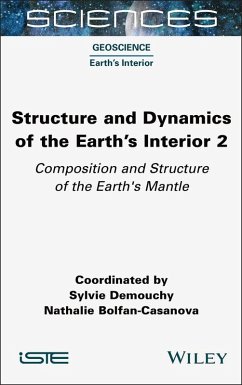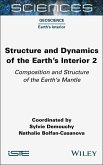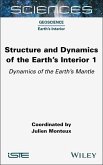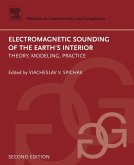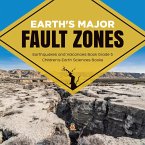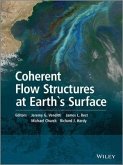Sylvie Demouchy, Nathalie Bolfan-Casanova
Structure and Dynamics of the Earth's Interior 2 (eBook, ePUB)
Composition and Structure of the Earth's Mantle
143,99 €
143,99 €
inkl. MwSt.
Sofort per Download lieferbar

0 °P sammeln
143,99 €
Als Download kaufen

143,99 €
inkl. MwSt.
Sofort per Download lieferbar

0 °P sammeln
Jetzt verschenken
Alle Infos zum eBook verschenken
143,99 €
inkl. MwSt.
Sofort per Download lieferbar
Alle Infos zum eBook verschenken

0 °P sammeln
Sylvie Demouchy, Nathalie Bolfan-Casanova
Structure and Dynamics of the Earth's Interior 2 (eBook, ePUB)
Composition and Structure of the Earth's Mantle
- Format: ePub
- Merkliste
- Auf die Merkliste
- Bewerten Bewerten
- Teilen
- Produkt teilen
- Produkterinnerung
- Produkterinnerung

Bitte loggen Sie sich zunächst in Ihr Kundenkonto ein oder registrieren Sie sich bei
bücher.de, um das eBook-Abo tolino select nutzen zu können.
Hier können Sie sich einloggen
Hier können Sie sich einloggen
Sie sind bereits eingeloggt. Klicken Sie auf 2. tolino select Abo, um fortzufahren.

Bitte loggen Sie sich zunächst in Ihr Kundenkonto ein oder registrieren Sie sich bei bücher.de, um das eBook-Abo tolino select nutzen zu können.
The interior of our planet is one of the last 'terra incognita'. Its chemical composition and onion-like structure of solid rocks and rare minerals make it a fascinating object. It is primarily its dynamic that makes Earth such a singular object in the solar system, with perennial, active plate tectonics for several billion years.
While its dynamic is obvious on the surface (earthquakes, volcanic eruptions, mid-oceanic rifts), the very nature of the Earth's mantle - beneath the crust and in contact with the core - has not revealed all of its secrets.
Structure and Dynamics of the Earth's…mehr
- Geräte: eReader
- mit Kopierschutz
- eBook Hilfe
- Größe: 14.13MB
Andere Kunden interessierten sich auch für
![Structure and Dynamics of the Earth's Interior 2 (eBook, PDF) Structure and Dynamics of the Earth's Interior 2 (eBook, PDF)]() Sylvie DemouchyStructure and Dynamics of the Earth's Interior 2 (eBook, PDF)143,99 €
Sylvie DemouchyStructure and Dynamics of the Earth's Interior 2 (eBook, PDF)143,99 €![Structure and Dynamics of the Earth's Interior 1 (eBook, ePUB) Structure and Dynamics of the Earth's Interior 1 (eBook, ePUB)]() Julien MonteuxStructure and Dynamics of the Earth's Interior 1 (eBook, ePUB)143,99 €
Julien MonteuxStructure and Dynamics of the Earth's Interior 1 (eBook, ePUB)143,99 €![Electromagnetic Sounding of the Earth's Interior (eBook, ePUB) Electromagnetic Sounding of the Earth's Interior (eBook, ePUB)]() Viacheslav V. SpichakElectromagnetic Sounding of the Earth's Interior (eBook, ePUB)104,95 €
Viacheslav V. SpichakElectromagnetic Sounding of the Earth's Interior (eBook, ePUB)104,95 €![Earth's Major Fault Zones Earthquakes and Volcanoes Book Grade 5 Children's Earth Sciences Books (eBook, ePUB) Earth's Major Fault Zones Earthquakes and Volcanoes Book Grade 5 Children's Earth Sciences Books (eBook, ePUB)]() BabyEarth's Major Fault Zones Earthquakes and Volcanoes Book Grade 5 Children's Earth Sciences Books (eBook, ePUB)2,99 €
BabyEarth's Major Fault Zones Earthquakes and Volcanoes Book Grade 5 Children's Earth Sciences Books (eBook, ePUB)2,99 €![Dynamics of the Earth's Radiation Belts and Inner Magnetosphere (eBook, ePUB) Dynamics of the Earth's Radiation Belts and Inner Magnetosphere (eBook, ePUB)]() Dynamics of the Earth's Radiation Belts and Inner Magnetosphere (eBook, ePUB)122,99 €
Dynamics of the Earth's Radiation Belts and Inner Magnetosphere (eBook, ePUB)122,99 €![Coherent Flow Structures at Earth's Surface (eBook, ePUB) Coherent Flow Structures at Earth's Surface (eBook, ePUB)]() Jeremy G. VendittiCoherent Flow Structures at Earth's Surface (eBook, ePUB)116,99 €
Jeremy G. VendittiCoherent Flow Structures at Earth's Surface (eBook, ePUB)116,99 €![Geomorphology of Central America (eBook, ePUB) Geomorphology of Central America (eBook, ePUB)]() Jean Pierre BergoeingGeomorphology of Central America (eBook, ePUB)52,95 €
Jean Pierre BergoeingGeomorphology of Central America (eBook, ePUB)52,95 €-
-
-
The interior of our planet is one of the last 'terra incognita'. Its chemical composition and onion-like structure of solid rocks and rare minerals make it a fascinating object. It is primarily its dynamic that makes Earth such a singular object in the solar system, with perennial, active plate tectonics for several billion years.
While its dynamic is obvious on the surface (earthquakes, volcanic eruptions, mid-oceanic rifts), the very nature of the Earth's mantle - beneath the crust and in contact with the core - has not revealed all of its secrets.
Structure and Dynamics of the Earth's Interior 2 recalls the fundamental principles of several key physicochemical properties of the materials which make up the Earth's mantle. This book then describes the latest technological advances used at high pressures and temperatures to reproduce the extreme conditions of the Earth's mantle in the laboratory. It also presents the latest and most significant scientific results.
While its dynamic is obvious on the surface (earthquakes, volcanic eruptions, mid-oceanic rifts), the very nature of the Earth's mantle - beneath the crust and in contact with the core - has not revealed all of its secrets.
Structure and Dynamics of the Earth's Interior 2 recalls the fundamental principles of several key physicochemical properties of the materials which make up the Earth's mantle. This book then describes the latest technological advances used at high pressures and temperatures to reproduce the extreme conditions of the Earth's mantle in the laboratory. It also presents the latest and most significant scientific results.
Dieser Download kann aus rechtlichen Gründen nur mit Rechnungsadresse in D ausgeliefert werden.
Produktdetails
- Produktdetails
- Verlag: Wiley
- Seitenzahl: 464
- Erscheinungstermin: 27. Februar 2025
- Englisch
- ISBN-13: 9781394361762
- Artikelnr.: 73584170
- Verlag: Wiley
- Seitenzahl: 464
- Erscheinungstermin: 27. Februar 2025
- Englisch
- ISBN-13: 9781394361762
- Artikelnr.: 73584170
- Herstellerkennzeichnung Die Herstellerinformationen sind derzeit nicht verfügbar.
Sylvie Demouchy is Research Director at the CNRS, France, and joined the Magmas and Volcanoes Laboratory in 2022. She is a geologist and experimentalist specializing in defects in deep Earth minerals.
Nathalie Bolfan-Casanova is Research Director at the CNRS, France, and joined the Magmas and Volcanoes Laboratory in 2003. She is a spectroscopist and experimentalist specializing in the incorporation of water into the deep Earth.
Nathalie Bolfan-Casanova is Research Director at the CNRS, France, and joined the Magmas and Volcanoes Laboratory in 2003. She is a spectroscopist and experimentalist specializing in the incorporation of water into the deep Earth.
Foreword xi Michel GRÉGOIRE Chapter 1 The Earth's Mantle: Phase Diagrams and Mineralogical Composition 1 Jean-Philippe PERRILLAT 1.1 Introduction 1 1.2 Phase relationships: experiments and models 2 1.3 Minerals in the Earth's mantle 7 1.4 Phase diagrams of ultra basic rocks, seismic discontinuities and mantle dynamics 17 1.5 Phase diagram of subducted basalts and fate of plates in the deep mantle 21 1.6 D" zone and bridgmanite-post-perovskite transition 23 1.7 Conclusion 24 1.8 References 25 Chapter 2 Seismology of the Earth's Mantle 33 Stéphanie DURAND, Benoît TAUZIN and Éric DEBAYLE 2.1 Introduction 33 2.2 The architecture of the mantle: seismic discontinuities 39 2.3 The drapery: three-dimensional variations of seismic velocities 52 2.4 Mantle flow and partial melting: seismic anisotropy and attenuation 61 2.5 References 68 Chapter 3 The Deep Hydrogen Cycle 83 Nathalie BOLFAN-CASANOVA and Bertrand MOINE 3.1 Introduction 83 3.2 The origin of terrestrial water 84 3.4 Hydrothermal weathering on the ocean floor 101 3.5 References 107 Chapter 4 The Role of Volatile CO2 -H2O Species in the Melting of the Earth's Mantle 115 Malcolm MASSUYEAU and Tahar HAMMOUDA 4.1 Presence and storage of carbon and hydrogen in the upper mantle 116 4.2 Effects of CO2 and H2O on melting temperatures in the Earth's peridotitic mantle 118 4.3 Composition of mantle magmas in the presence of CO2 and H2O 125 4.4 Impact of CO2 and H2O on the mantle's geophysical signatures 133 4.5 References 135 Chapter 5 Oxygen Fugacity in the Mantle 147 Alan B. WOODLAND 5.1 Introduction 147 5.2 Equilibria with iron oxides 147 5.3 The significance of oxygen fugacity 151 5.4 The
O2 importance for processes in the Earth's interior 154 5.5 Determining the
O2 content of a rock 164 5.6 The
O2 of the upper mantle (lithospheric) 169 5.7 Redox conditions in the deep mantle 178 5.8 A final word 181 5.9 References 182 Chapter 6 Elasticity and Composition of the Earth's Mantle 193 Tiziana BOFFA-BALLARAN 6.1 Elasticity 194 6.2 Elastic waves 203 6.3 Polycrystalline materials 206 6.4 Experimental techniques 208 6.5 Models of the Earth's interior 212 6.6 References 216 Chapter 7 Earth's Mantle Rheology 221 Sylvie DEMOUCHY and Patrick CORDIER 7.1 Introduction 221 7.2 Ductile deformation: mechanisms 223 7.3 Observables 231 7.4 Methodological approaches 233 7.5 Deformation in the upper mantle 237 7.6 Deformation in the mantle transition zone 240 7.7 Deformation in the lower mantle 242 7.8 Conclusion 244 7.9 References 245 Chapter 8 Laboratory Measurements of Electrical Conductivity and their Applications to Planetary Interiors 249 Geeth MANTHILAKE 8.1 Theoretical background 249 8.2 Laboratory measurements of electrical conductivity 251 8.3 Laboratory measurements of electrical conductivity 255 8.4 Electrical conductivity of a composite medium 257 8.5 Factors affecting the electrical conductivity of planetary materials 258 8.6 The modeling of electrical conductivity data for planetary applications 265 8.7 References 273 List of Authors 279 Index 281
O2 importance for processes in the Earth's interior 154 5.5 Determining the
O2 content of a rock 164 5.6 The
O2 of the upper mantle (lithospheric) 169 5.7 Redox conditions in the deep mantle 178 5.8 A final word 181 5.9 References 182 Chapter 6 Elasticity and Composition of the Earth's Mantle 193 Tiziana BOFFA-BALLARAN 6.1 Elasticity 194 6.2 Elastic waves 203 6.3 Polycrystalline materials 206 6.4 Experimental techniques 208 6.5 Models of the Earth's interior 212 6.6 References 216 Chapter 7 Earth's Mantle Rheology 221 Sylvie DEMOUCHY and Patrick CORDIER 7.1 Introduction 221 7.2 Ductile deformation: mechanisms 223 7.3 Observables 231 7.4 Methodological approaches 233 7.5 Deformation in the upper mantle 237 7.6 Deformation in the mantle transition zone 240 7.7 Deformation in the lower mantle 242 7.8 Conclusion 244 7.9 References 245 Chapter 8 Laboratory Measurements of Electrical Conductivity and their Applications to Planetary Interiors 249 Geeth MANTHILAKE 8.1 Theoretical background 249 8.2 Laboratory measurements of electrical conductivity 251 8.3 Laboratory measurements of electrical conductivity 255 8.4 Electrical conductivity of a composite medium 257 8.5 Factors affecting the electrical conductivity of planetary materials 258 8.6 The modeling of electrical conductivity data for planetary applications 265 8.7 References 273 List of Authors 279 Index 281
Foreword xi Michel GRÉGOIRE Chapter 1 The Earth's Mantle: Phase Diagrams and Mineralogical Composition 1 Jean-Philippe PERRILLAT 1.1 Introduction 1 1.2 Phase relationships: experiments and models 2 1.3 Minerals in the Earth's mantle 7 1.4 Phase diagrams of ultra basic rocks, seismic discontinuities and mantle dynamics 17 1.5 Phase diagram of subducted basalts and fate of plates in the deep mantle 21 1.6 D" zone and bridgmanite-post-perovskite transition 23 1.7 Conclusion 24 1.8 References 25 Chapter 2 Seismology of the Earth's Mantle 33 Stéphanie DURAND, Benoît TAUZIN and Éric DEBAYLE 2.1 Introduction 33 2.2 The architecture of the mantle: seismic discontinuities 39 2.3 The drapery: three-dimensional variations of seismic velocities 52 2.4 Mantle flow and partial melting: seismic anisotropy and attenuation 61 2.5 References 68 Chapter 3 The Deep Hydrogen Cycle 83 Nathalie BOLFAN-CASANOVA and Bertrand MOINE 3.1 Introduction 83 3.2 The origin of terrestrial water 84 3.4 Hydrothermal weathering on the ocean floor 101 3.5 References 107 Chapter 4 The Role of Volatile CO2 -H2O Species in the Melting of the Earth's Mantle 115 Malcolm MASSUYEAU and Tahar HAMMOUDA 4.1 Presence and storage of carbon and hydrogen in the upper mantle 116 4.2 Effects of CO2 and H2O on melting temperatures in the Earth's peridotitic mantle 118 4.3 Composition of mantle magmas in the presence of CO2 and H2O 125 4.4 Impact of CO2 and H2O on the mantle's geophysical signatures 133 4.5 References 135 Chapter 5 Oxygen Fugacity in the Mantle 147 Alan B. WOODLAND 5.1 Introduction 147 5.2 Equilibria with iron oxides 147 5.3 The significance of oxygen fugacity 151 5.4 The
O2 importance for processes in the Earth's interior 154 5.5 Determining the
O2 content of a rock 164 5.6 The
O2 of the upper mantle (lithospheric) 169 5.7 Redox conditions in the deep mantle 178 5.8 A final word 181 5.9 References 182 Chapter 6 Elasticity and Composition of the Earth's Mantle 193 Tiziana BOFFA-BALLARAN 6.1 Elasticity 194 6.2 Elastic waves 203 6.3 Polycrystalline materials 206 6.4 Experimental techniques 208 6.5 Models of the Earth's interior 212 6.6 References 216 Chapter 7 Earth's Mantle Rheology 221 Sylvie DEMOUCHY and Patrick CORDIER 7.1 Introduction 221 7.2 Ductile deformation: mechanisms 223 7.3 Observables 231 7.4 Methodological approaches 233 7.5 Deformation in the upper mantle 237 7.6 Deformation in the mantle transition zone 240 7.7 Deformation in the lower mantle 242 7.8 Conclusion 244 7.9 References 245 Chapter 8 Laboratory Measurements of Electrical Conductivity and their Applications to Planetary Interiors 249 Geeth MANTHILAKE 8.1 Theoretical background 249 8.2 Laboratory measurements of electrical conductivity 251 8.3 Laboratory measurements of electrical conductivity 255 8.4 Electrical conductivity of a composite medium 257 8.5 Factors affecting the electrical conductivity of planetary materials 258 8.6 The modeling of electrical conductivity data for planetary applications 265 8.7 References 273 List of Authors 279 Index 281
O2 importance for processes in the Earth's interior 154 5.5 Determining the
O2 content of a rock 164 5.6 The
O2 of the upper mantle (lithospheric) 169 5.7 Redox conditions in the deep mantle 178 5.8 A final word 181 5.9 References 182 Chapter 6 Elasticity and Composition of the Earth's Mantle 193 Tiziana BOFFA-BALLARAN 6.1 Elasticity 194 6.2 Elastic waves 203 6.3 Polycrystalline materials 206 6.4 Experimental techniques 208 6.5 Models of the Earth's interior 212 6.6 References 216 Chapter 7 Earth's Mantle Rheology 221 Sylvie DEMOUCHY and Patrick CORDIER 7.1 Introduction 221 7.2 Ductile deformation: mechanisms 223 7.3 Observables 231 7.4 Methodological approaches 233 7.5 Deformation in the upper mantle 237 7.6 Deformation in the mantle transition zone 240 7.7 Deformation in the lower mantle 242 7.8 Conclusion 244 7.9 References 245 Chapter 8 Laboratory Measurements of Electrical Conductivity and their Applications to Planetary Interiors 249 Geeth MANTHILAKE 8.1 Theoretical background 249 8.2 Laboratory measurements of electrical conductivity 251 8.3 Laboratory measurements of electrical conductivity 255 8.4 Electrical conductivity of a composite medium 257 8.5 Factors affecting the electrical conductivity of planetary materials 258 8.6 The modeling of electrical conductivity data for planetary applications 265 8.7 References 273 List of Authors 279 Index 281
